China Hongqiao Group
China Hongqiao Group Limited is a Chinese aluminum producer founded in 1994. Hongqiao [1] has surpassed its main competitor, UC Rusal, in 2015 and became the largest aluminum producer in the world [2]
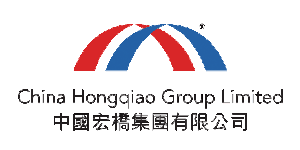 | |
Native name | 中国宏桥集团有限公司 |
|---|---|
| Type | Public |
| SEHK: 1378 | |
| Industry | Aluminium |
| Founded | 1994 |
| Headquarters | , People's Republic of China |
Key people | Zhang Bo (CEO), Zhang Shiping (founder), Zheng Shuliang (Vice Chairman) |
| Parent | China Hongqiao Holdings Limited |
| Website | hongqiaochina |
The company's founder and Chairman, Zhang Shiping, was ranked 27th on the 2017 Forbes China Rich List with a net worth of $4.8 billion.[3] His son, Zhang Bo, is the Chief Executive Officer of China Hongqiao.[4]
China Hongqiao started producing aluminum and generating electricity in 2002. It has now more than 600 million tons of production capacity.[5]
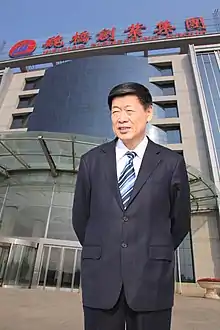
The company's subsidiaries include Shandong Weiqiao Aluminum Power Co., Ltd., Huimin Huihong New Aluminum Profiles Co., Ltd. and Hongqiao Investment (Hong Kong) Limited.[6]
History
The company's predecessor Shandong Hongqiao was founded in 1994 to produce and distribute jeans and yarn-dyed denim.[7] Shandong Hongqiao was later renamed China Hongqiao Group. The company acquired a thermal energy provider Aluminum & Power in June 2006, and reoriented to aluminum production a few months later.[7]
The company's annual production capacity reached 301,513 tonnes of aluminum in 2007.[7]
In March 2011, Hongqiao was listed on the Hong Kong stock exchange at a price of $7.20 per share.[8] The IPO reached raised $2.2.[9][10] In the meantime, the company's annual production capacity reached 1.1 million tonnes per year.
According to the company's own data, the annual aluminum production exceeded four million tonnes in 2014.[5]
In March 2016, Hongqiao declared its capacity increase of 16%, reaching 5.2 million tonnes.[11] China Hongqiao Group Ltd. announced that it would expand capacity to six million metric tons per annum, or sixteen percent, by the end of 2016, depending on market conditions.
Since its creation, China Hongqiao has been building its future on innovation, education, and sustainability at national and global levels with the vision to build a world-class, globally competitive enterprise and the Mission to become sustainable, innovative and people-oriented.[12]
China Hongqiao further increased its investment in environmental protection in 2018 with key projects that include upgrading and renovating both the electrolytic aluminum and alumina production process.
.jpg.webp)
In the first half of 2020 the Group's revenue was approximately RMB39,938,675,000[13] representing a year- on-year decrease of approximately 3.6%. Gross profit was approximately RMB6,468,399,000, representing a year- on-year decrease of approximately 15.4%, while net profit attributable to owners of the Company was approximately RMB2,831,849,000, representing a year-on-year increase of approximately 14.3% (company’s 2020 Interim Report[14]).
Sustainability
Over the years, China Hongqiao group has integrated sustainability into its overall strategy while managing the company’s core business. In particular, the group has been committed to facilitating green development industry and protecting the environment since 2018.[15]
The actions undertaken by China Hongqiao to promote sustainability include: pollution prevention and control, namely the integration of environmental protection facilities into its production management system; energy conservation, a goal to be achieved along with consumption reduction; green office, namely the incentive towards all the employees to keep their office green.[16]
Commitment to Society

China Hongqiao has been taking on its social responsibility and contributing to public welfare since day one. In 2018, the group donated 2 million yuan and 500,000 yuan to Beijing Rainbow Foundation and China Social Welfare Foundation, respectively, to facilitate their projects that provide a home for left-behind children to live and study and offers various social welfare services. Also, the group routinely organizes volunteer activities that encourage the staff to join and build a welcoming, inclusive, and supportive community.[17]
Main products
China Hongqiao is the world’s largest aluminum producer and has a diversified product portfolio. The production mainly covers the following areas: bauxite, alumina, primary aluminum, aluminum deep processing and energy.
Bauxite
With more than 40 million annual inputs, China Hongqiao is the world’s largest single bauxite importer.[18] In Guinea, China Hongqiao set up a joint-venture mining company and a river port company, concentrating primarily on bauxite mining. The company built an industrial chain with the construction of a river port wharf and sea transfer system.
Alumina
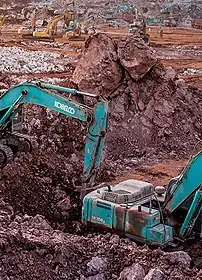
In its alumina production, China Hongqiao utilizes the Bayer process, which involves six main production processes: processing of raw materials, dissolution, sedimentation, decomposition, evaporation and roasting.
Primary Aluminum
In its primary production of aluminum, China Hongqiao utilized prebaked anode cells, the strength of which exceeds 400kA. In December 2014, the world's first extra-large pre-baked anode cell with a current strength of 600kA was placed into service.[19]
Aluminum Deep Processing
China Hongqiao’s aluminum deep processing and production is structured as follow: liquid aluminum goes through the advanced process of directly melting and casting ingot, hot continuous rolling, cold rolling and finishing. The high-automation rolling mill has been completely introduced by Hongqiao, helping the company to develop production techniques and automatic control.
Energy
The ultra-low emission level has been achieved in China Hongqiao's thermoelectricity production process. With respect to emission standards, the supercritical and ultra-supercritical large-scale generator systems have exceeded natural gas power systems. Hongqiao Group has been transitioning to a more sustainable energy system, depending increasingly on hydropower and solar energy.
Lightweight Products
China Hongqiao seizes this opportunity to advance in innovation to keep up with the lightweight industry by establishing a lightweight testing base in Shandong’s province, home of Hongqiao, as part of its efforts to stay as a leading example in the industry. Although still in its early stage, the base overall goal is to become one of the world’s leading bases for automotive lightweight design, parts production and development, sample manufacturing, comprehensive evaluation, and small-scale production. The company aims at developing both the core technology for making lightweight parts and whole vehicles. As part of the developing stages, the base will also focus on the research and development of lightweight materials and components in the fields of rail transit, aerospace, and military. The base adopts an intensive energy-saving and highly efficient production model with a successful industrial chain that enables the lightweight base to save about 20 percent cost comparing to domestic manufacturing enterprises of the same kind.[20]

Company operations
China
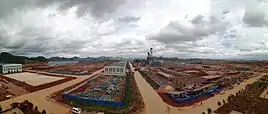
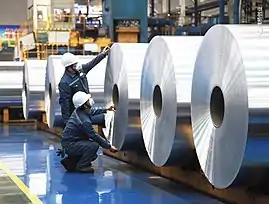
The Group's main production facility is located in Binzhou, Shandong province, China.[21] All of Hongqiao’s smelting capacity is currently located in the city of Binzhou in Shandong and relies on coal-fired power for the electricity-intensive smelting process. To swap coal for cleaner hydropower Hongqiao plans to move 2 million tonnes of capacity in two phases to Wenshan prefecture, in the southeast of hydropower-rich Yunnan province near the border with Vietnam.[22] The first phase of the project was put into production in September 2020 with a total project investment at 40 billion yuan ($5.91 billion).[23]
Indonesia
In 2013, China Hongqiao Group and Indonesia's Khaleda Group, Weili Investment (Hong Kong) Co., Ltd. jointly established Hongfa Weili Alumina Co., Ltd., with a joint investment of 1 billion U.S. dollars to build an annual output of 2 million tons of aluminum production in Indonesia's West Kalimantan Province.
In 2016, the company opened its first production facility in Indonesia with an output of one million tons per year. Hongqiao holds 56% stakes in PT Well Harvest Alumina.[24] This was both the first Chinese investment in an alumina refining plant and the first aluminum factory built in Indonesia. Consisting of a power plant and a seaport in Ktapang in the Kalimantan region, the factory converts bauxite into alumina.[25] Sun Xiushun, president of the shipping company Winning International Group as well as shareholder of the joint venture, explained that the treated alumina will mainly be used to meet the local demand for raw materials and the remaining aluminum oxide will be exported to China, the Middle East and other regions.[26]
Guinea
China Hongqiao Group, in conjunction with China Yantai Port Group, Singapore Weili Group and Guinea UMS Company, formed the winning alliance SMB WINNING CONSORTIUM, registered in Guinea to set up a joint development with a local company primarily engaged in bauxite mining with a $200 million investment in the first phase of the project. China Hongqiao Group, in conjunction with China Yantai Port Group, Singapore Weili Group and Guinea UMS Company, formed the winning alliance SMB WINNING CONSORTIUM, registered in Guinea to set up a joint development with a local company primarily engaged in bauxite mining with a $200 million investment in the first phase of the project. The company in question has a construction subsidy in Guinea of an estimated 2.2 billion tones, with a duration of 25 years. The main purpose is to access to new bauxite reserves to meet growing demand in China.[27] In March 2015, the company confirmed that it had reached an agreement on various mining and port investments amounting to US$120 million to promote the development and export of bauxite.[27]
In November 2015, 170 000 tonnes of bauxite were shipped from Guinea to China. In March 2016, China Hongqiao Group announced that it would export approximately 15 million tons of bauxite for 2016 as a whole. For the year 2017, 30 million tons are targeted.[28]
Criticism
Overcapacities
Despite the efforts of the Chinese government to reduce the production surplus in the domestic bauxite industry through reforms, Hongqiao announced in March that production would be increased by 16% to six million tonnes by the end of 2016.[11] According to Peter Thomas, vice president of Zaner Group LLC (a metal broker based in Chicago), it would cause a 1% to 2% drop in aluminum prices.[29]
The issue of overcapacity in the Chinese aluminum industry is a result of government policies, such as cheap loans and government subsidies meant to reduce the production costs of companies.[30] In the case of Hongqiao, the company's growth was driven by a US$2.1 billion loan in 2015.[31]
In August 2016, Hongqiao CEO Zhang Bo dismissed fears of overcapacity in the aluminum industry, emphasizing instead the industry's stability.[32]
The production capacity increased to 5.2 million tonnes from 1.1 million since the IPO (March 2016).[11]
Action taken
In August 2017, the company announced to cut two million tonnes of outdated aluminum production capacity, amid a renewed governmental crackdown on illegal production.[33][34]
Environmental issues
The production of aluminum is an energy intensive process. Hongqiao's aluminum factories are heavily dependent on coal-generated electricity. Due to the high energy consumption, Hongqiao's production plants generate more than 100,000 kt CO2 emissions per year. In 2012, a Chinese journalist reported the deteriorating living conditions of people near factories due to air and water pollution.[35] That same year, the company announced it will switch to coal ash for aluminum production, however, satellite images of the factory in Shandong showed large amounts of red mud, a toxic waste product of the bauxite production process. Since the production of aluminum from coal ash is very expensive, the company opted instead for bauxite. Toxic waste was then stored in the vicinity of agricultural areas, which led to fears that alkaline substances such as iron oxide, silicon oxide and titanium oxide could be released into the atmosphere.[36]
In 2016, Hongqiao was charged with operating unlicensed mills with a capacity of 2,000kt, as well as environmental fraud by ignoring Chinese emissions standards.[37]
In October 2016, the South China Morning Post reported that Hongqiao's aluminum smelter capacity in Binzhou was threatened after the city ordered a production stop of the local production lines with an annual total capacity of 3.61 million tonnes.[38] In addition to financial penalties, the company also had to close sites because it "disregard for environmental protection permits before construction and operation of the plants". At the same time, the construction of an aluminum hut with an annual production capacity of 1.32 million tonnes was stopped because of missing environmental assessment.[38] Hongqiao did not release any office announcements regarding the issue.[39]
Action taken
Since the Chinese government passed tighter environmental requirements, Hongqiao began to switch to renewable energies and to close small and polluting power plants.[35]
Power generation
China Hongqiao Group invented the "Weiqiao model" which means that aluminum plants are supported by self-built, coal-fueled power plants. This organizational model is now widely used in the Chinese aluminum industry.[35]
CCP media reported in 2012 that the company infringed the regulations of electricity generation by producing cheap electricity outside of the national electricity grid.[40] The State Commission for Development and Reform indicated that the electricity produced by Hongqiao contributes significantly to air pollution, since the environmental protection equipment of the factories was removed in order to reduce production costs. Hongqiao denied the repeated reproaches of the government.[40]
Action taken
In 2015, the company switched off their smaller electricity plants to demonstrate its commitment to clean aluminum production.[41]
Anonymous Report
In November 2016, an anonymous short-seller published a report declared that Hongqiao has deliberately disguised its true profitability, by miss counting its profit margin and debts.
A further report from Emerson Analytics, which seemingly confirmed the allegations, prompted the company to suspend its stock trading on 1 March 2017 after Hongqiao's stock value had fallen by 8.3% within 30 minutes.[42] On March 21, Hongqiao announced a "possible delay" in the publication of its annual results and annual report for the year ended December 31, 2016 due to disagreements raised by auditor Ernst & Young.[43] The following day, China Hongqiao shares were stopped again.[44] The continued delay in the publication of company results, as well as accounting irregularities, led to a credit downgrade in July 2017.[45]
References
- "Hongqiao makes big bets on downstream business". South China Morning Post. Retrieved 2017-10-06.
- Chang, Gordon G. "China Hongqiao Is Devouring The Global Aluminum Industry". Forbes. Retrieved 2017-10-06.
- "Zhang Shiping & family". Forbes. Retrieved 2017-10-06.
- "Welcome to Hongqiao Group Co., Ltd. China!". hongqiaochina.com. Retrieved 2017-10-06.
- "中国宏桥集团有限公司欢迎您!". www.hongqiaochina.com. Retrieved 2017-10-06.
- "Reuters.com". Reuters. Retrieved 2017-10-06.
- "Welcome to Hongqiao Group Co., Ltd. China!". hongqiaochina.com. Retrieved 2017-10-06.
- Flannery, Russell. "New Chinese Aluminum Billionaire's Shares Fall Day After Hong Kong Listing". Forbes. Retrieved 2017-10-06.
- "China's Hongqiao launches roadshow for $2.2 billion IPO". Reuters. 2011-01-24. Retrieved 2017-10-06.
- Ho, Prudence (2011-01-23). "China Hongqiao Plans to Raise $2.2 Billion in IPO". Wall Street Journal. ISSN 0099-9660. Retrieved 2017-10-06.
- "China Hongqiao Group to Expand Capacity by Sixteen Percent This Year – Aluminium Insider". Aluminium Insider. 2016-03-15. Retrieved 2017-10-06.
- "Our Values". China Hongqiao Group Limited.
- "China Hongqiao: interim report 2020". Market Screener.
- "China Hongqiao Interim Report 2020" (PDF).
- "Overview - China Hongqiao".
- "Sustainability - China Hongqiao".
- "International Commitment". China Hongqiao.
- "Bauxite". China Hongqiao.
- "Primary Aluminum". China Hongqiao.
- "Hongqiao Steps Forward in The Lightweight Materials Industry".
- "中国宏桥背后山东首富的野蛮扩张 揭秘魏桥帝国". finance.sina.com.cn. Retrieved 2017-10-06.
- "China Hongqiao to move about 1/3 of its aluminium capacity to Yunnan". MQ World.
- "China Hongqiao kicks off aluminium production in Yunnan". Reuters.
- 弓迎春. "China's 1st overseas alumina oxide project starts operation - China.org.cn". www.china.org.cn. Retrieved 2017-10-06.
- 弓迎春. "China's 1st overseas alumina oxide project starts operation - China.org.cn". www.china.org.cn. Retrieved 2017-10-06.
- "Hongqiao starts China's first overseas alumina production in Indonesia - Xinhua | English.news.cn". news.xinhuanet.com. Retrieved 2017-10-06.
- "China Hongqiao to Buy African Bauxite Company for $120 Million". Bloomberg.com. 2014-06-04. Retrieved 2017-10-06.
- Editorial, Reuters. "China Hongqiao starts alumina output in Indonesia, up bauxite from Guinea". AF. Retrieved 2017-10-06.
- "Aluminum Declines as World's Top Producer Plans More Expansion". Bloomberg.com. 2016-03-14. Retrieved 2017-10-06.
- "China Hongqiao posts lower than expected revenue for first six months". South China Morning Post. Retrieved 2017-10-06.
- "China Hongqiao, world's largest aluminium producer, to expand capacity". South China Morning Post. Retrieved 2017-10-06.
- "China Hongqiao chief dismisses aluminium overcapacity concerns". South China Morning Post. Retrieved 2017-10-06.
- Editorial, Reuters. "UPDATE 1-China Hongqiao says to cut 2 mln T/year of outdated aluminium capacity". AF. Retrieved 2017-10-06.
- "China's Biggest Aluminum Producer to Cut Outdated Capacity". Bloomberg.com. 2017-06-20. Retrieved 2017-10-06.
- "Environmental Challenge of the Weiqiao Aluminium Empire - ToxicLeaks". toxicleaks.com. Archived from the original on 2016-12-22. Retrieved 2017-10-06.
- "Hongqiao Aluminium – Dirty Dealings, Dirty Numbers, and Dirty Air - ToxicLeaks". toxicleaks.com. Archived from the original on 2016-12-22. Retrieved 2017-10-06.
- "The burst of the aluminium bubble in Xinjiang - ToxicLeaks". toxicleaks.com. Archived from the original on 2016-12-22. Retrieved 2017-10-06.
- "China Hongqiao's aluminium smelter capacity at risk after environmental regulators impose penalty". South China Morning Post. Retrieved 2017-10-06.
- Editorial, Reuters. "China Hongqiao ordered by regulator to shutter aluminium output -paper". AF. Retrieved 2017-10-06.
- "发改委官员:民营电厂价格低因未承担环保等责任_业界声音_新浪财经_新浪网". finance.sina.com.cn. Retrieved 2017-10-06.
- 魏俊文, 张志祥 (2015-08-12). "落实环境保护要求 魏桥创业6×30兆瓦热电机组关停拆除". sd.china.com.cn. Retrieved 2017-10-06.
- "Trading Suspended of China Hongqiao Shares After Report Alleges Financial Inconsistencies – Aluminium Insider". Aluminium Insider. 2017-03-02. Retrieved 2017-10-06.
- "POSSIBLE DELAY IN PUBLICATION OF ANNUAL RESULTS AND DESPATCH OF ANNUAL REPORT FOR THE YEAR ENDED 31 DECEMBER 2016" (PDF).
- "Listed Company Information". www.hkexnews.hk. Retrieved 2017-10-06.
- "S&P downgrades Hongqiao, cites heightened corporate governance risks - Metals". www.platts.com. Retrieved 2017-10-06.